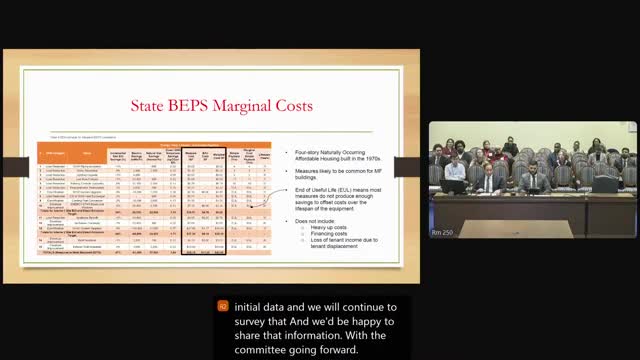Montgomery County faces housing crisis as BEPS compliance costs soar 300 to 400 percent
January 14, 2025 | Environment and Transportation Committee, HOUSE OF REPRESENTATIVES, Committees, Legislative, Maryland
This article was created by AI summarizing key points discussed. AI makes mistakes, so for full details and context, please refer to the video of the full meeting. Please report any errors so we can fix them. Report an error »

The Maryland General Assembly's Environment and Transportation (ENT) Committee convened on January 14, 2025, to discuss critical issues surrounding the Building Energy Performance Standards (BEPS) and their implications for affordable housing. A key takeaway from the meeting was the alarming revelation that compliance costs with BEPS could be significantly higher than previously estimated, potentially reaching 300% to 400% more than standard operational costs.
During the session, representatives from the Apartment and Office Building Association (AOBA) presented findings from a recent analysis that highlighted the financial burden of BEPS compliance. The analysis indicated that while the initial estimates suggested a marginal cost increase of around 30%, the reality is far more daunting. The costs associated with necessary upgrades—such as replacing traditional heating systems with heat pumps—are not only substantial but also often do not yield a return on investment over their lifespan. This situation raises concerns about the sustainability of affordable housing in Maryland, as property owners may be forced to pass these costs onto tenants through significant rent increases.
The committee also examined the implications of alternative compliance fees linked to BEPS. If property owners do not meet energy use intensity (EUI) targets, they could face steep fees, necessitating annual rent hikes of approximately 6% to offset these costs. Even with energy efficiency measures in place, rent increases could still reach around 3% annually. This scenario poses a significant challenge for renters, particularly in light of existing rent control laws in Montgomery and Prince George's Counties, which may limit landlords' ability to recover these costs.
The discussion further delved into the broader context of housing supply and demand. While some committee members expressed concerns about the potential negative impact of rent stabilization measures on housing development, others emphasized the need for a balanced approach that protects renters without stifling new construction. The committee acknowledged the complexity of the housing market, noting that while there may be an increase in available units, there remains a critical shortage of affordable housing options.
As the committee continues to navigate these pressing issues, the implications of BEPS compliance and alternative fees will be pivotal in shaping Maryland's housing landscape. Stakeholders are urged to consider the long-term effects of these regulations on both property owners and renters, as the state seeks to balance environmental goals with the urgent need for affordable housing solutions.
During the session, representatives from the Apartment and Office Building Association (AOBA) presented findings from a recent analysis that highlighted the financial burden of BEPS compliance. The analysis indicated that while the initial estimates suggested a marginal cost increase of around 30%, the reality is far more daunting. The costs associated with necessary upgrades—such as replacing traditional heating systems with heat pumps—are not only substantial but also often do not yield a return on investment over their lifespan. This situation raises concerns about the sustainability of affordable housing in Maryland, as property owners may be forced to pass these costs onto tenants through significant rent increases.
The committee also examined the implications of alternative compliance fees linked to BEPS. If property owners do not meet energy use intensity (EUI) targets, they could face steep fees, necessitating annual rent hikes of approximately 6% to offset these costs. Even with energy efficiency measures in place, rent increases could still reach around 3% annually. This scenario poses a significant challenge for renters, particularly in light of existing rent control laws in Montgomery and Prince George's Counties, which may limit landlords' ability to recover these costs.
The discussion further delved into the broader context of housing supply and demand. While some committee members expressed concerns about the potential negative impact of rent stabilization measures on housing development, others emphasized the need for a balanced approach that protects renters without stifling new construction. The committee acknowledged the complexity of the housing market, noting that while there may be an increase in available units, there remains a critical shortage of affordable housing options.
As the committee continues to navigate these pressing issues, the implications of BEPS compliance and alternative fees will be pivotal in shaping Maryland's housing landscape. Stakeholders are urged to consider the long-term effects of these regulations on both property owners and renters, as the state seeks to balance environmental goals with the urgent need for affordable housing solutions.
View full meeting
This article is based on a recent meeting—watch the full video and explore the complete transcript for deeper insights into the discussion.
View full meeting
